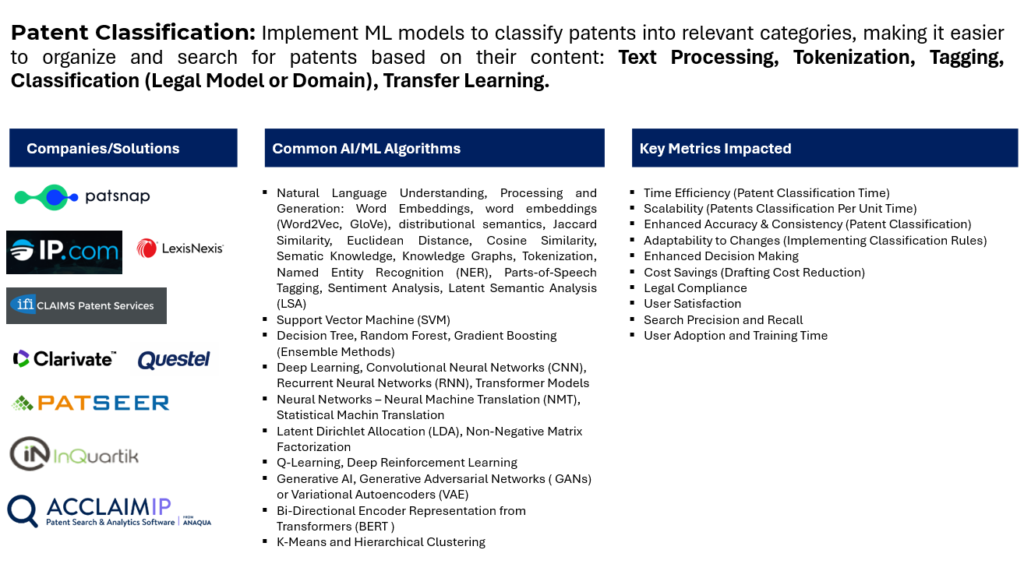Artificial Intelligence (AI) and Machine Learning (ML) can significantly impact patent management by automating and optimizing various tasks. By leveraging AI and ML in these areas, patent management processes can become more efficient, accurate, and proactive, ultimately enhancing the overall effectiveness of intellectual property management strategies. There are several applications and areas where AI/ML can be applied in patent management: Prior Art Search, Automated Patent Drafting, Patent Classification, Patent Valuation, Automated Patent Filing and Prosecution, Patent Portfolio Management, Patent Analytics, Infringement Detection, Technology Landscape Analysis, Patent Litigation Support, Automated Patent Maintenance and Collaborative Innovation Platforms.
C: Patent Classification
AI/ML is being increasingly leveraged for patent classification to automate and enhance the categorization of patents into predefined classes or categories. Patent classification is a crucial step in organizing vast patent databases and improving search and retrieval processes. AI/ML technologies are transforming patent classification by improving accuracy, efficiency, and adaptability. Establishing clear OKRs, KPIs, and metrics helps organizations set specific goals, measure progress, and evaluate the success of their AI/ML-driven patent classification initiatives : (1) Increase efficiency in patent classification. (2) Achieve a reduction in average processing time per patent within specficied number of months. (3) Improve accuracy and consistency in patent classifications. (4) Attain a classification accuracy rate of certain % or higher as measured by an independent audit. (5) Enhance scalability for handling a growing number of patents. (6) Increase throughput to classify patents per day within the next quarter. (7) Achieve cost savings in patent classification efforts. Reduce the cost per patent classification by % over the next fiscal year. (8) Enable adaptability to changes in patent law and regulations. (9) Implement updates or changes to the classification rules within certain number of weeks of their announcement. (10) Facilitate better decision-making through accurate patent classifications. (11) Improve user satisfaction with the system, as measured by a certain increase in user feedback scores.
Companies that integrate these technologies into their patent platforms provide users with powerful tools for navigating and understanding patent landscapes. Google Patents uses machine learning to classify patents into technology domains. It leverages advanced search capabilities and categorization to enhance patent discovery. IBM Watson for Patents employs AI and NLP to analyze and categorize patents. It assists users in exploring and understanding patent landscapes. Clarivate Analytics utilizes AI-driven features in its Derwent Innovation platform to enhance patent classification and categorization. It aids in navigating patent data for research and analysis. Questel’s employs AI technologies for patent classification, making it easier for users to search and analyze patent information. Here are some companies that were known for leveraging AI/ML for patent classification: Gridlogics (PatSeer): Overview: Gridlogics provides PatSeer, an AI-driven patent search and analytics platform. It utilizes machine learning techniques for patent classification, enhancing search capabilities and analysis. IFI CLAIMS Patent Services: IFI CLAIMS Patent Services is known for its patent data solutions. The company employs AI and machine learning for patent classification, providing data services and analytics for patent professionals.
PatSnap: Overview: PatSnap is an IP intelligence platform that utilizes AI for various tasks, including patent classification. The platform assists in prior art searches, patent analysis, and managing intellectual property portfolios. IP.com (InnovationQ Plus): IP.com offers InnovationQ Plus, a platform utilizing AI for patent searching and classification. It includes features for patent analytics, trend identification, and intellectual property management. Anaqua: Anaqua provides IP management solutions, and their platform incorporates AI-driven tools for patent analytics and classification. It helps in managing the entire lifecycle of intellectual property, including patent classification. InQuartik Corporation (Patentcloud): InQuartik’s Patentcloud platform includes AI-driven tools for patent analysis and may involve features for patent classification. The platform offers various IP intelligence services. Cipher.ai: Cipher.ai specializes in AI-driven IP analytics. While not limited to classification, it may incorporate AI techniques for analyzing and managing patent portfolios.

Natural Language Processing (NLP): Technique: AI/ML algorithms, especially those involving NLP, analyze the text of patent documents to identify keywords, phrases, and technical terms. Improves accuracy in understanding and classifying patents based on their content. Machine learning models are trained on large datasets of labeled patents to learn patterns and associations between text features and specific patent classes. Increases automation and efficiency in assigning appropriate classifications, reducing the manual workload. Semantic Analysis: AI models perform semantic analysis to understand the context and meaning of patent documents, allowing for more accurate classification. Enhances precision in categorizing patents based on their conceptual content. Deep Learning: Deep learning algorithms, including neural networks, can automatically extract hierarchical features from patent texts, aiding in classification. Improves scalability and adaptability to complex patent structures.
Benefits of AI/ML in Patent Classification: Increased Efficiency: AI/ML automates the patent classification process, reducing the time and effort required for manual categorization. Enhanced Accuracy: Machine learning models improve the accuracy of patent classification by learning from large datasets and identifying intricate patterns. Improved Search and Retrieval: AI-powered classification enhances the precision of patent searches, making it easier for inventors, researchers, and legal professionals to retrieve relevant information. Adaptability to Changes: AI models can adapt to evolving technologies and emerging trends, ensuring that patent classification remains effective in dynamic industries. Scalability: With AI/ML, the process of classifying patents can scale efficiently to handle the growing volume of patent applications worldwide.
Automating patent classification using AI and ML can lead to various benefits, and organizations typically establish objectives (OKRs), key performance indicators (KPIs), and metrics to measure the impact and success of the automation process. Efficiency and Time Savings: Time taken to classify a patent using the automated system. Increase efficiency in the patent classification process. Time taken for patent classification before and after automation. Reduction in manual effort and resources. Accuracy and Consistency: Improve the accuracy and consistency of patent classifications. Accuracy rates in classifying patents. Consistency across different classifiers or classification iterations. Percentage of patents correctly classified by the automated system. Frequency of misclassifications or errors in the automated classification. Scalability: Enable scalability of patent classification efforts. Volume of patents processed per unit of time. Ability to handle an increasing number of patents. Cost Savings: Achieve cost savings in patent classification processes. Reduction in labor costs associated with manual classification. Overall cost savings in the patent workflow.
Improved Search and Retrieval: Enhance searchability and retrieval of relevant patents. Precision and recall in search results. Speed of retrieving relevant patents. Adaptability to Changes: Build a system that adapts to changes in patent law and emerging technologies. Time taken to implement changes or updates in classification rules. Accuracy in adapting to new patent classifications. Enhanced Decision-Making: Facilitate better decision-making based on accurately classified patent data. Accuracy of information used for strategic decision-making. Quality of insights derived from classified patent data.
Throughput: Number of patents classified per unit of time. Cost per Classification: Cost associated with classifying a single patent using the automated system. Adaptability Metrics: Time and resources required to update the system for changes in classification rules or regulations. User Satisfaction: Feedback from users, patent professionals, or stakeholders on the effectiveness and usability of the automated classification system. Search Precision and Recall: The ratio of relevant patents to the total patents retrieved. The ratio of relevant patents retrieved to the total relevant patents. System Uptime and Reliability: Availability and reliability of the automated system for patent classification. Cost Savings Percentage: Percentage reduction in costs associated with manual patent classification.
References
Patent Classification:
Book: “Manual of Patent Examining Procedure (MPEP)” by United States Patent and Trademark Office (USPTO)
Article: “Patent Classification Systems – A Guide for Inventors” by Michael Lin (IPWatchdog, 2019)
Website: United States Patent Classification (USPC) System on USPTO
Course: “Patent Classification: Everything You Need to Know” on PatentResourcesGroup.com
Research Paper: “A Comprehensive Survey of Software Approaches to Patent Classification” by P. G. Nair and K. S. Rajasekaran (International Journal of Computer Applications, 2014)




